Organize!
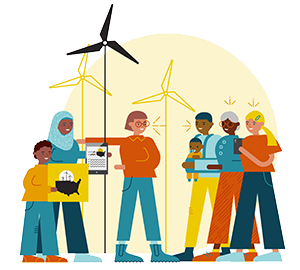
Build Public Support
Remember: a campaign is a series of tactics building the strength of the team and putting increasing pressure on the decision maker until they take action moving the community to 100% clean, renewable energy. A campaign is not a series of events with a clean energy theme. It requires a planned out strategy with a tangible, long-term goal in mind.
Organizing tactics should do at least one of these three things:
-
Educate: Build supporters, equip your team with information to share with others, explain the issue to your decision makers.
-
Build your power: Expand your team and grow their skills.
-
Pressure your decision maker: Demonstrate the power you’ve built.
For example, if your campaign plan includes a milestone of getting a superintendent to support a goal of 100% for all local school buildings, you’ll want to organize constituents that will influence them, such as parents, teachers, or students. Begin by educating and building public support with those groups through family-friendly film nights, presentations at PTA meetings, handing out informational flyers at school board meetings, sitting down with leadership of the teachers’ union, or working with a high school group to research local clean energy solutions to share with their principal.
Other organizing tactics could include: petitioning, writing letters, having face-to-face meetings, call-ins, education meetings, teach-ins, or rallies.
No matter what your tactic is, there are a few things to keep in mind:
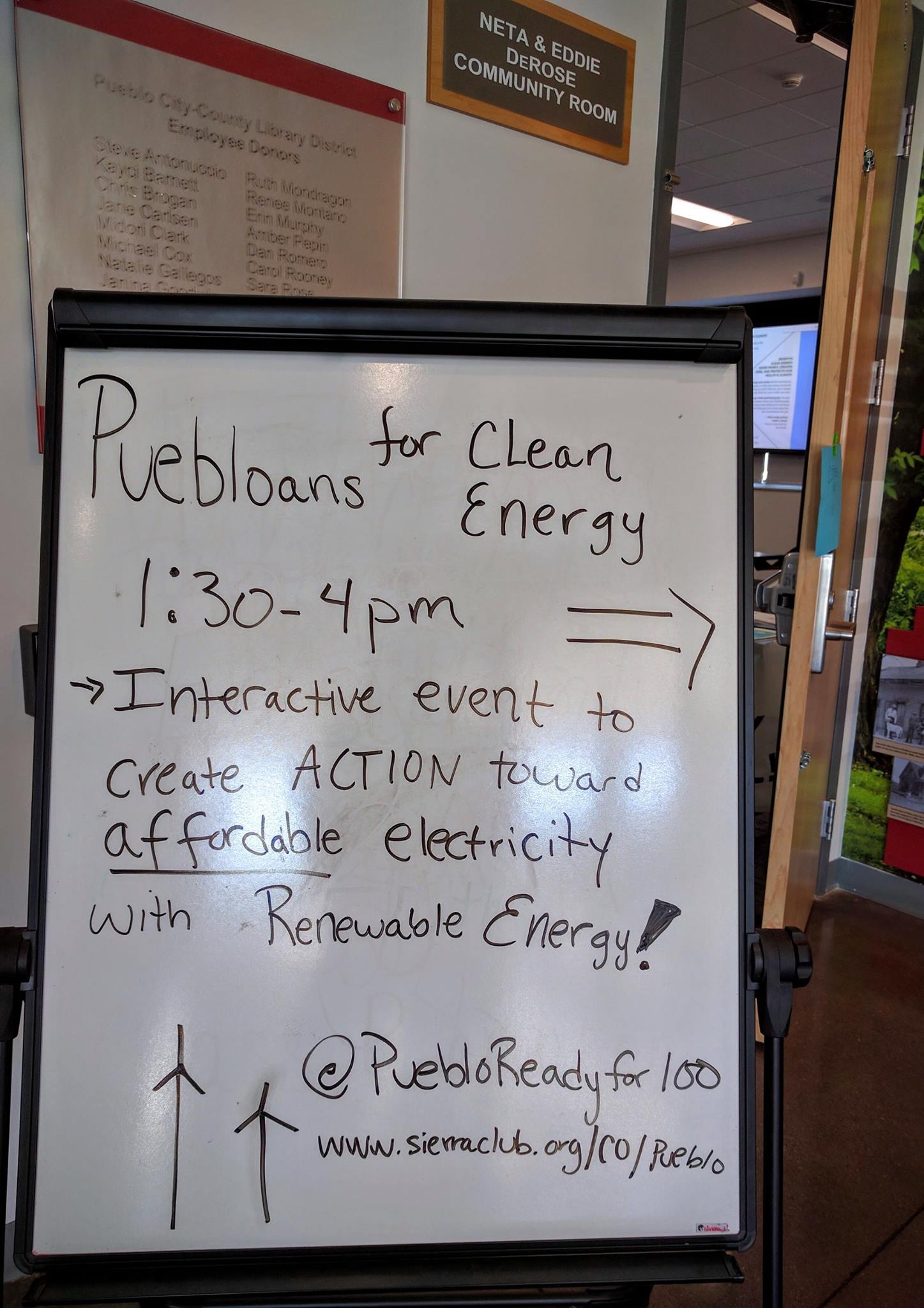
Community action night at the library in Pueblo, CO. | Photo by Meral Sarper.
-
Recruit, recruit, recruit. Especially for your first campaign ‘Kick Off’ event, getting people there is the top priority. You may have perfect sign-in sheets and delicious food, but if no one shows up, the event fails. Don’t let this happen to you! (Remember the best practices of recruitment and growing your team discussed in Phase 2.)
-
Delegate, delegate, delegate. Shared work is critical to campaign success. The nature of organizing is that you will build something that is bigger than you, and that’s awesome. That also means you’ll have more to do than one person can do. That’s when you must give up control, ask a lot of others, and train new leaders to get it all done.
-
Sign everyone in. After all that recruitment, you want to know who showed up. You can’t thank them or invite them to the next thing if you don’t know who they are or how to contact them. Determine what is the best way to database this information by talking with your local Sierra Club contact.
-
Indoors: use AddUp or have a sign-in sheet to collect people’s contact information.
-
Outdoors: circulate petition cards or sign in sheets on clipboards that also collect contact information.
-
Follow up. Contact each new person individually, preferably by phone, within two days of the event. Use this time to find out about their interests and motivations. Ask them to get involved by inviting them to the next meeting or event.
As you can see, the first piece to this is key—recruitment. There are many ways to recruit (some methods more effective than others), but petitions are a critical tool to collect contact information to use throughout your campaign.
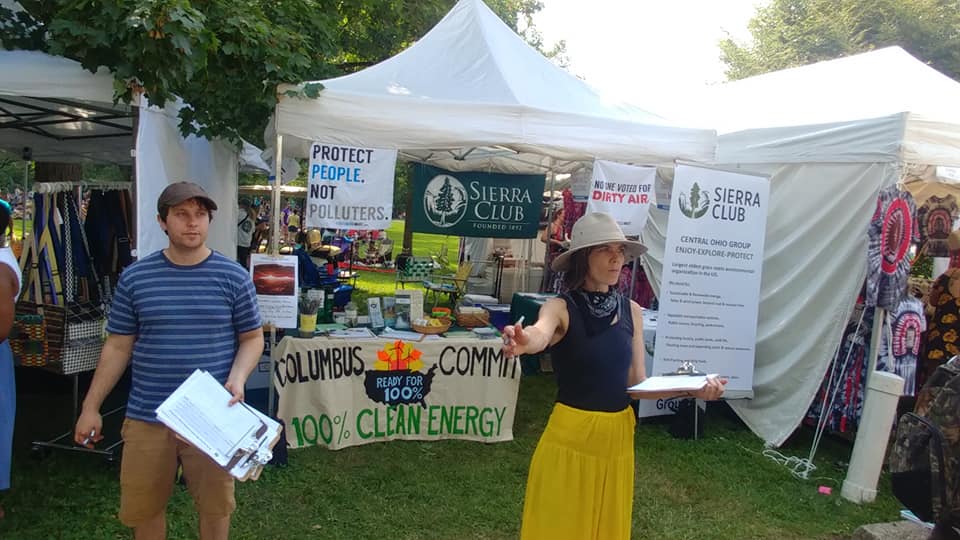
Summer community fair tabling in Columbus, OH, to collect petitions asking the mayor to support clean energy.
Some popular tactics to use during this recruitment and power-building phase are:
-
Community education events: Town halls, panel discussions, book clubs, debates, or film nights are some ways to educate your community about the issue. Have a way for people to take action at these events after getting them all fired up about why they should!
-
Outings: Outdoor activities are a great way to connect people with one another and with the places they seek to protect. It can be an opportunity to share personal stories, perform service work (such as helping with energy-efficiency projects), or as a means to connect your group to the vision (such as a tour of a wind farm). Find more information on this local Sierra Club Outings page for Sierra Club volunteers or email local.outings@sierraclub.org.
-
Presentations: Working to deliver presentations about the campaign to organizations, classrooms, film audiences or neighborhood associations is another way to expand the networks and breadth of the campaign. Before presenting to a group, gain an understanding of the group’s purpose, its members, history, norms and decision making process, so you are meeting them on their level. Here’s a sample from the Manatee Clean Energy Alliance. Or use our Sample Overview Powerpoint Presentation to develop your own.
-
Trainings: Train the folks involved in your campaign up until this point in skills like how to do one-on-ones, how to center your campaign equity and create inclusive spaces, and how to facilitate community dialogues. Trainings provide the people involved with another way to build relationships with each other and increase their organizing and campaign skills. Use our core training modules as you desire.
-
House parties or meetings: Holding an informal event either in people’s homes or at a local community center, restaurant, or library can allow people to connect to the campaign and each other. Use this event to help educate the community about your issue and get the word out about how to take action and get involved as a volunteer in the campaign. Consider having people sign the petition as they enter and write a letter to the editor as their action—either during the event or as the ‘take-home’ ask. Here’s a guide to hosting a house party.
While organizing, it is important to be reflecting and checking in on how the Campaign Principles are being applied to your campaign. Embracing these principles are necessary if we wish to be part of building a larger progressive movement.
Worksheet
Pivoting to Principled Practice Worksheet
Use this worksheet to reflect on and evaluate your local campaign. Take inventory on where you are and how to improve.
Meet with Your Decision Maker
You have a plan and know what you’re asking for, you have expanded your network, built support for your issue, and refined your message and presentation. It’s finally time to see what impact the campaign has had and where your decision maker is on clean energy. Set up an initial meeting with the decision maker you’ve identified in your campaign plan (made in Phase 3).
Setting up this meeting is easy — your leader is meant to represent you. As a constituent, you’re their boss, so they have every reason to say yes. Your mayor or local leader cares about things that make them look responsive and hardworking to the people of their community. That means that there are some things they care about very much, and other things very little:
|
Your decision maker cares a lot about: |
They don’t care much about: |
|---|---|
|
Support from their constituents |
People who aren’t their constituents |
|
Local press and editorials |
A 20+ page review or analysis of anything |
|
Advocacy from real people — calls, personal emails, handwritten letters, especially people who show up in person |
Form letters, a single tweet, or a Facebook comment (unless there are dozens) |
|
A clear, concrete ask that they know how to solve — sign this letter, make a public statement, attend this meeting, etc. |
General ideas or a laundry list of concerns |
To set up a meeting, send an email and follow up with a call to make sure they got it and schedule a time to talk. Your decision maker may have open office hours. Ideally you can set up your own meeting time, but you can use those hours as an opportunity to drop by if one can’t be scheduled!
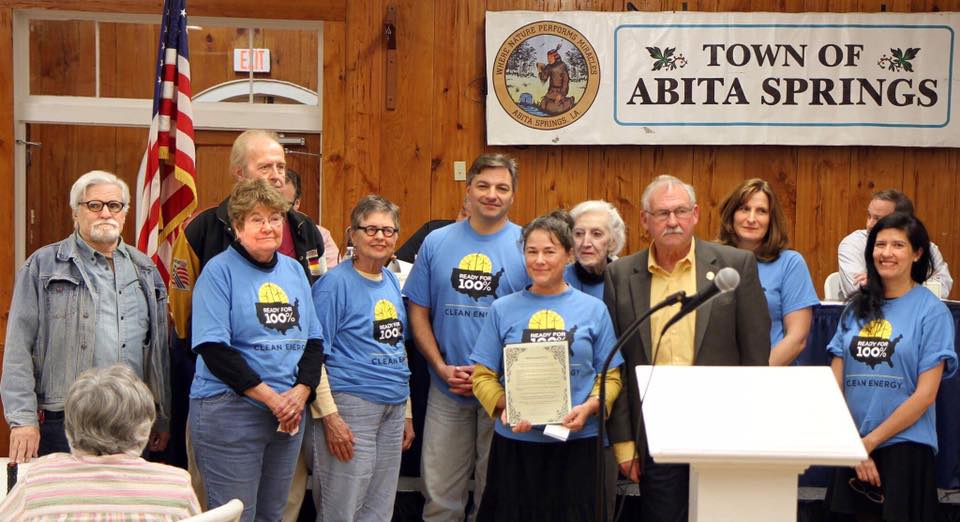
The team in Abita Springs, LA, was presented with a proclamation in support of 100% by the mayor. | Photo by George Long.
Bring a few folks with you to meet with your mayor or local leader. These meetings are to introduce you to your target and to introduce them to your campaign. Talk to your public leaders and their staff (ideally in person), introduce yourselves with your personal narratives, use your action narrative to explain what benefits transitioning to 100% clean energy will bring to your community (find a quick summary on this factsheet), and ask what they think! Then listen. The goal of this meeting is for your team to gain an understanding of where the decision maker is on the issue, not for you to lay out the entire campaign.
If they’re asking for more information, you can share:
What you learn from this meeting will allow you to make adjustments to your campaign plan, messaging and powermap so your team is even more strategic and effective.
Generally these meetings are only scheduled for 15-20 minutes, so be prompt and concise. Here’s a sample agenda you can use to draft your own.
Sample Agenda (follows the acronym: IPSUAPS)
-
Introductions: Have each person share their name, neighborhood, and connection to the campaign. One or two people with compelling stories connected to the self-interest of your decision maker should share their personal stories.
-
Problem: What is a local problem that your community is facing that the transition to 100% clean, renewable energy could solve? High or unstable energy costs, unemployment or wage stagnation, climate change impacts, local health problems?
-
Solution: Mayors are leading the country’s transition to 100% clean renewable energy which solves our issues of … by …
-
Urgency: Now is the time for action by endorsing a goal of 100% clean, renewable energy here in (NAME OF CITY, TOWN) because we are facing … threat and have … opportunity.
-
Ask: Will you work with us to set a visionary goal of 100% clean, renewable energy for our community? These are our 100% renewable energy commitment guidelines to example commitments that other cities have made. We’re ready to help make this possible. Let us know what you need in order to lead on clean energy.
-
Personal Story: While your local leader is looking over the materials, have more folks share their story of self and how they are personally impacted and how 100% clean, renewable energy would help.
This meeting can go two ways. You will lay out the case on why your community is ready for 100% clean energy and give them a heads up that this campaign is happening. Then, they will either not be on board yet, so you promise to follow up to answer any questions, or they say yes! Do not take your decision makers’s words at face value. Stating support is a lot easier than taking action, so always push them to set a next step. How can they get the ball rolling on a clean energy policy? How can they voice support publicly? Remember, you want to convert them into an active ally, not just a passive one.
Follow up! Be ready to send a card or email thanking them for the meeting or commitment, and follow up with any materials or resources they requested. Being persistent yet polite is key. Call and email them regularly with updates or news on the issue worth sharing, and continue to ask if the decision maker is ready to lead on 100% clean, renewable energy.
Show Power
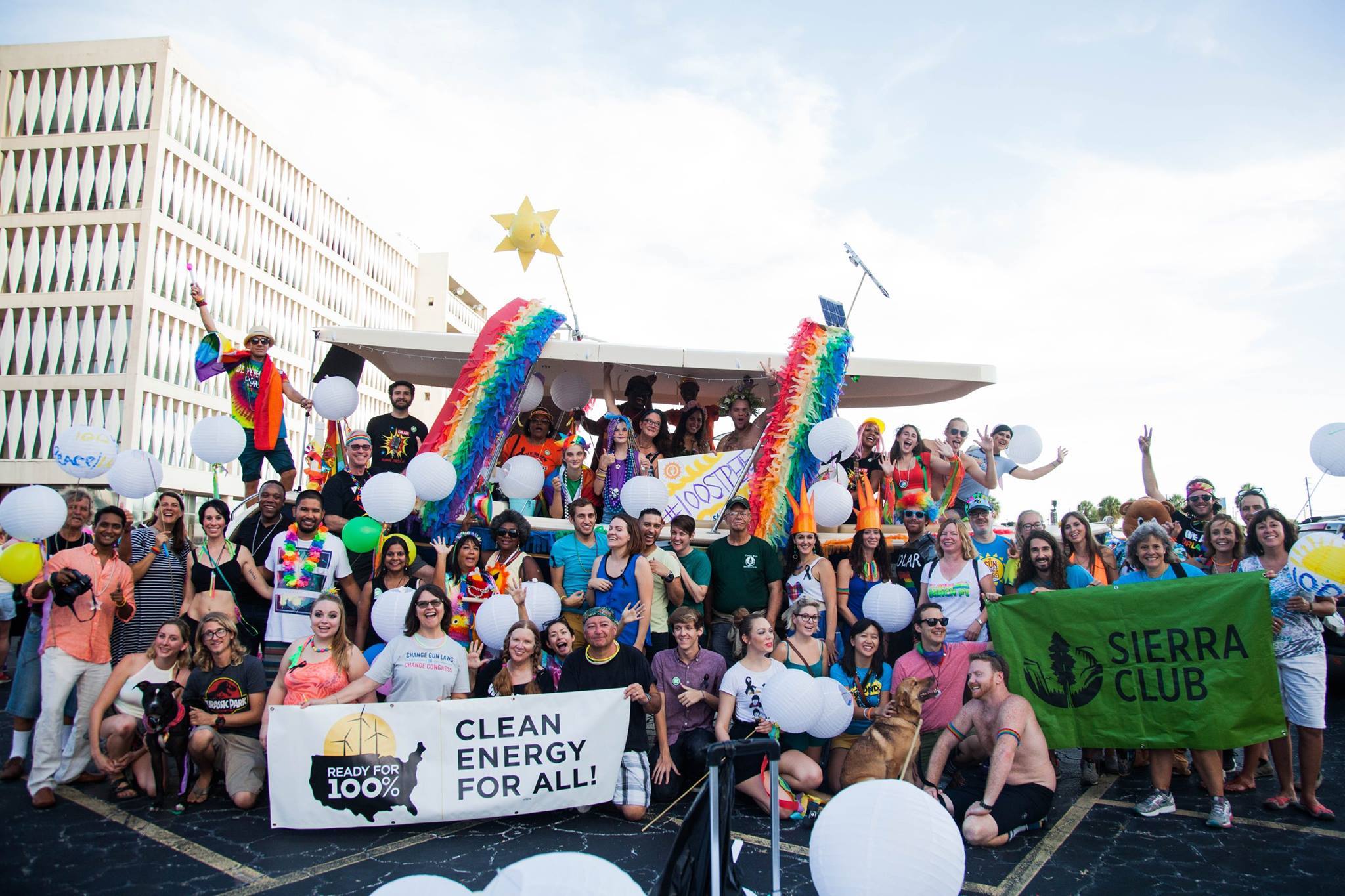
100% St. Pete participated in the St. Petersburgh, FL, Pride Parade. | Photo by Shannon Kalahar.
You want decision makers to take you seriously so they will decide in your favor. Showing power is about building a visible, physical, credible presence to your decision makers and the community. Demonstrate that your campaign is a genuine reflection of the community’s will. There will be key moments when support is measured and major decisions are made. If you have effectively shown power, your decision makers will know that standing against your campaign will undermine their standing in the community. Here are the critical ways to show your power throughout your campaign:
Participate in related local committees. Many local town or city committees are open to the public to join or participate. Some of the ones that you might be interested in connecting with may be called Buildings & Utilities, Development, Planning and Sustainability, Transportation, or Workforce & Community Benefits Committee. Each city may group these topics together differently. Offer to present the campaign to them and answer questions. These committees may be able to support your campaign and help move it to a victory faster.
Identify champions. Follow up from your education meetings and presentations and see what committees and leaders will lead the effort to commit the city to 100% clean energy. Champions are necessary to take your campaign over the finish line. It might be the mayor’s chief of staff who ultimately writes the mayor’s proclamation or a committee leader that makes the public statement. You want to be this person’s go-to.
Win milestones. Test your power building up to your campaign goal. Share these stories as updates on your AddUp campaign, on social media and with your decision makers. Look at how Boise, ID effectively used AddUp here.
Creatively earn media. Consider more public actions such as aerial photos, rallies and social media campaigns to spread your word to new audiences. Remember to use hashtags when posting photos online.
Deliver your petitions to your target. Take a look at this example petition drop-off plan on how to put a delivery event together to earn media.
Use creative tactics to keep the pressure on your decision maker. This might include setting up an art installation outside their office representing clean energy, it might be projecting a hashtag on the side of a building like the Boston team did (see a photo of the projection on Twitter), or getting together a bunch of kids to sing a song inside their office. Anything that is different from what you have already done will get the city officials’ attention and continue to build momentum in your campaign.
Secure a 100% Commitment
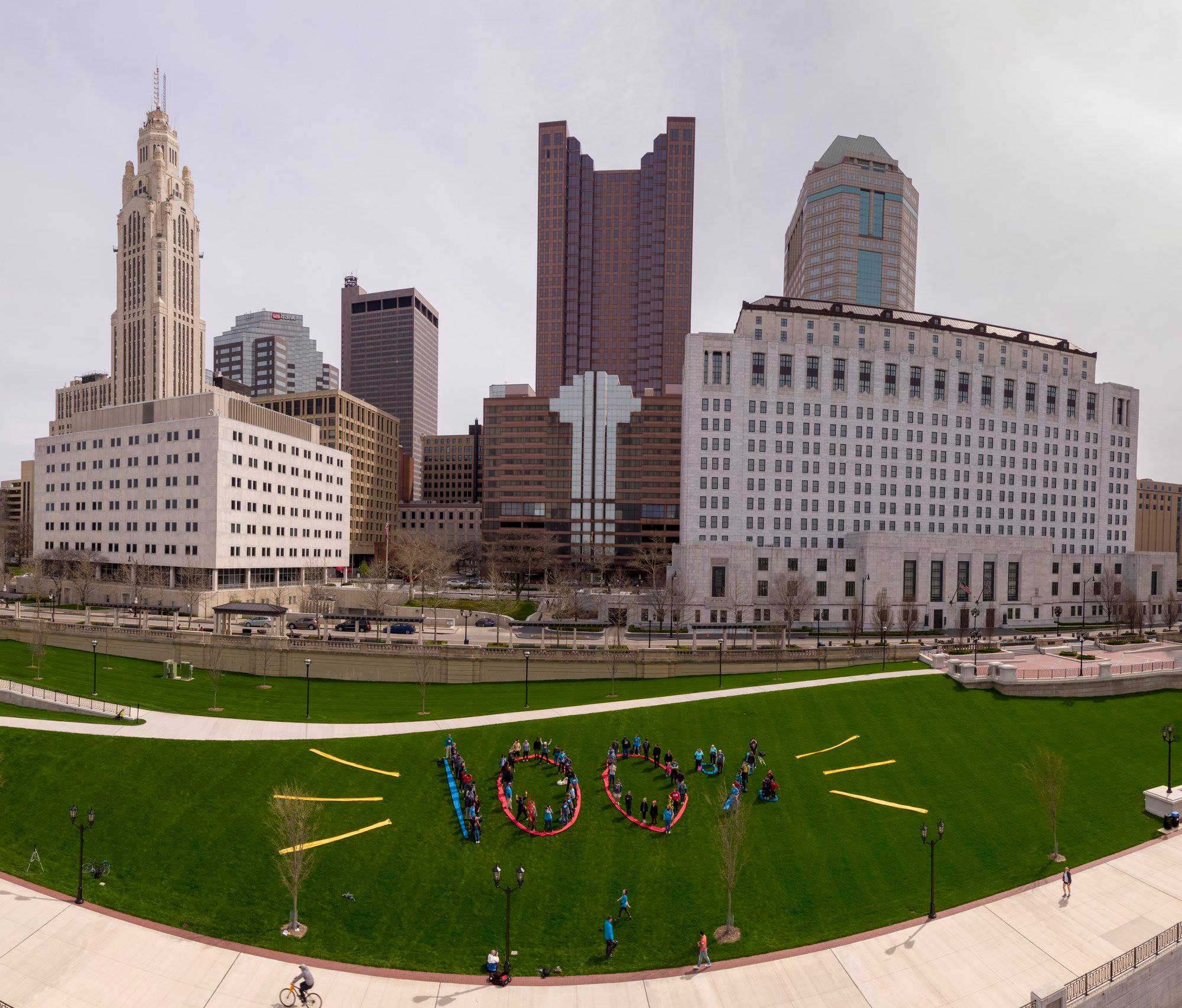
Columbus, OH, aerial art in support of 100% clean energy. | Photo by Perfect Perspectives.
Here you are! You’ve built public support, demonstrated demand for action and your community is ready for 100% clean energy. The commitment should set up a timeline to transition your community to 100%. When the commitment is made, it is important to demonstrate as much public support and celebration as possible so that the decision makers know that they’ll be held accountable to following through. (Remember, for C3 compliance, we cannot take credit for a victory won through the legislative process).
Here is a sample plan on what to do when things get rolling on your commitment:
|
Shape the commitment language |
|
|
During this process |
|
|
Choose a commitment date |
|
|
3 weeks before commitment |
|
|
2 weeks before commitment |
|
|
1 week before commitment |
|
|
2 days before commitment |
|
|
Commitment announced to public and press |
|
Prepare the press! In the weeks leading up to the commitment, it’s time to prepare a communications plan to let the media and broader audiences know what’s about to happen.
All About Communications
The Communications Guide has everything you need to plan a communication strategy and work with spokespeople and the media.
One communications tactic you might consider is working with your champion to co-write a press release (read a sample release from Hanover, NH) and ensure they plan to share it from their channels once you’ve succeeded in your goal. If this is not possible, your local team or coalition should plan to write and distribute its own press release to share with your media list as soon as the goal is met. Ask for quotes from team leaders and partners that reflect your community and the broad and diverse coalition you’ve built. This process of collecting quotes and finalizing the press materials can take a lot of time. This is the big story you share on the campaign, so give your team enough time to do this well.
It’s important that your team has its messaging prepared by the time of the commitment so you are prepared to share the story of your campaign with media and new audiences who might be hearing about this commitment for the first time. Your team should know who’s the point person for communicating with reporters and distributing your press release or other press materials. Remember that this person is not necessarily one of your spokespeople (the individuals being quoted or interviewed).
In addition to “winning the win” by having your celebratory press release at the ready, try to give your press contacts a few day's notice that the announcement is happening to maximize your chance for news coverage. Follow the Communications Guide for support on preparing your commitment press plan – and the Online Organizing guide to create a plan for sharing your news on social media.
For the day of the commitment, fill the room with clean energy supporters! Make an event on your AddUp page, send emails, make phone calls and remind everyone to attend. People in the room mean more to your target than names on a petition. Your target may receive pressure from the opposition minutes before they make their decision. Having a full room of supporters will hold them accountable to making the right choice.
The best way to ensure attendance to the commitment is to remind your attendees as the event approaches. It also gives you a chance to be sure that all attendees have the correct details about the event, where to park, and what to bring. In order to confirm your guests, you can:
-
Call: If you know them personally and have their contact information, speaking on the phone with your guests is the most effective way to ensure their attendance.
-
Text: Texting your attendees is another great way to confirm their attendance.
-
Message them on Facebook: If you don’t have their phone number, messaging your guests directly on Facebook is another effective way to confirm attendees to your event.
-
AddUp Update: As your event approaches don’t forget to do an Update on your AddUp campaign. By doing that, all of your AddUp action takers and RSVP’ers will get an email with your last-minute reminders.
-
Email: And if all else fails, send them another nudge via email.
When the commitment happens, take photos! Action photos of the commitment or a group photo of the decision maker with supporters are perfect for the press (see this photo from Pueblo, CO, or this photo from Miami Beach, FL). Share the photo on social media so others can find it and show support!
Now, Celebrate
A 100% renewable energy commitment for your community is an important first step along the path to clean energy for all. Don’t forget to celebrate your victory with the people who made it possible! Celebration is essential for building a healthy team. It’s a chance to reset and nourish the connections you’ve worked so hard to build. As an activist, you spend a lot of time struggling toward the change you want to see in this world. Take this opportunity to recognize that your team and coalition have successfully led your community closer to your vision for the future.
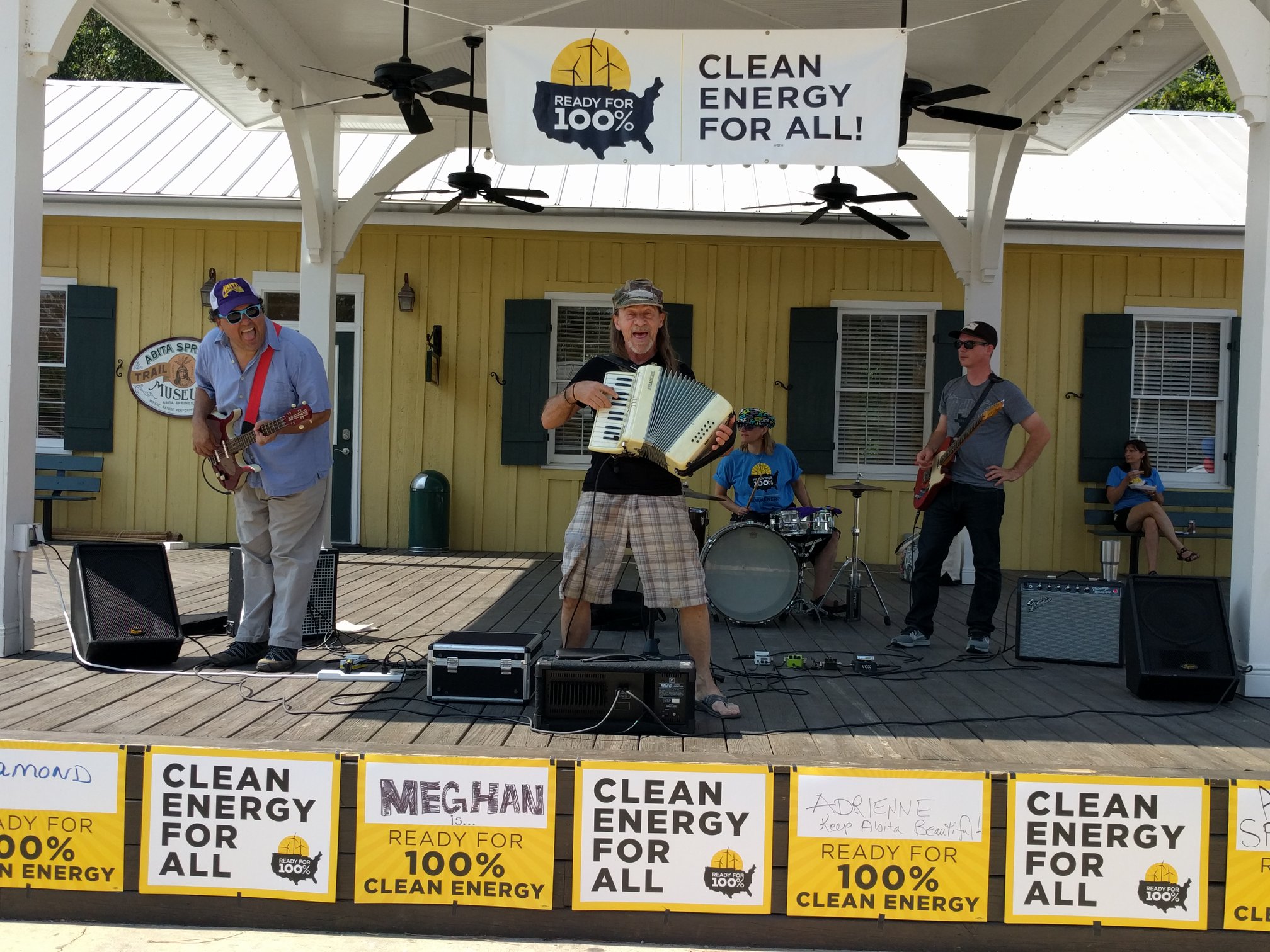
Free clean energy event and concert in Abita Springs, LA. | Photo by Margie Vicknair-Pray.
Try to answer these questions before moving on.
False! The best way to build your supporters list is to collect contact information at every event. Follow up right away with anyone who is new.
A. IPSUAPS will help keep you on track by reminding you to cover, in order: Introductions, Problem, Solution, Urgency, Ask, Personal Story.
False. To gain power with decision makers, you have to demonstrate that your campaign is a genuine reflection of the community’s will—not any one organization. To continue to build your power, get involved in community organizations, have a diverse team, find champions, and stay in the media.